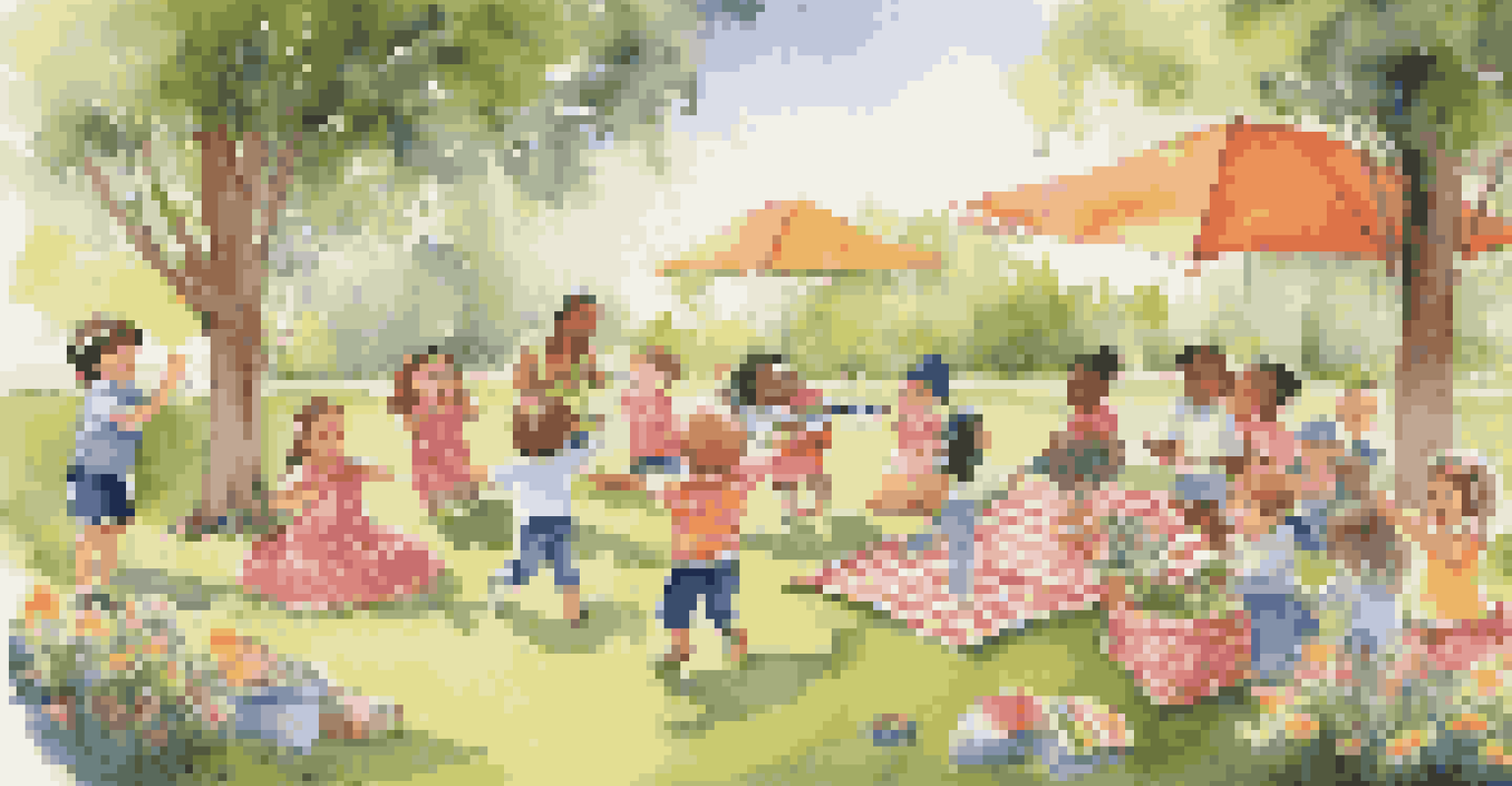The Influence of Music on Language Development in Children

Understanding the Connection Between Music and Language
Music and language share a deep-rooted connection, both relying on rhythm, pitch, and melody. Just as language has its own set of rules and structures, so does music. This shared foundation suggests that exposure to musical elements can enhance linguistic abilities in children, making music a powerful tool for language development.
Music is the shorthand of emotion.
Research indicates that children who engage with music at an early age often show improved verbal skills. For instance, singing nursery rhymes not only entertains but also helps children learn new words and understand sentence structure. This interplay between music and language encourages cognitive growth, as the brain actively processes both forms of expression.
Moreover, the emotional aspect of music can enhance language learning. Music often evokes emotions that words alone might not convey, allowing children to connect on a deeper level. This emotional connection fosters a more engaging learning environment, reinforcing language acquisition in a fun, memorable way.
The Role of Rhythm in Language Skills Development
Rhythm plays a crucial role in both music and language, serving as a bridge between the two. Just like a musical beat helps us keep time, the rhythmic patterns in speech help children understand the flow of language. By tapping into this natural rhythm, children can improve their speech patterns and pronunciation.

For example, clapping along to a song can help children internalize the rhythm of language. This kinesthetic approach makes learning interactive and encourages children to participate actively. As they clap and sing, they are also honing their listening skills, which are essential for effective communication.
Music Boosts Language Skills
Engaging with music enhances children's verbal skills and cognitive development through rhythm, melody, and emotional connection.
Incorporating rhythmic activities into language lessons can lead to enhanced phonemic awareness. Phonemic awareness involves recognizing and manipulating the sounds within words, a critical skill for reading development. By engaging with rhythm, children can develop a stronger foundation for their language skills.
Singing as a Tool for Vocabulary Expansion
Singing is an enjoyable way to introduce new vocabulary to children. Songs often contain repetitive phrases and catchy melodies, making it easier for young learners to remember new words. This repetition not only aids in retention but also provides context for how words are used in sentences.
The beautiful thing about learning is that no one can take it away from you.
Consider a simple song like 'Twinkle, Twinkle, Little Star.' The repetitive nature of the lyrics allows children to familiarize themselves with words like 'twinkle' and 'star' in a fun and engaging manner. This exposure helps solidify their understanding and encourages them to use these words in everyday conversations.
Furthermore, songs can introduce children to a wider range of vocabulary than they might encounter in regular speech. The imaginative lyrics and storytelling found in many children's songs stimulate creativity and inspire curiosity, leading to discussions that further enhance language development.
Enhancing Listening Skills Through Musical Exposure
Listening is a vital skill in language development, and music can significantly enhance this ability. When children listen to music, they train their ears to pick up different sounds, pitches, and rhythms, which directly translates to better listening skills in language. This heightened auditory awareness helps them understand nuances in speech, including tone and emotion.
Engaging with various musical genres exposes children to diverse sounds and styles, enriching their auditory experiences. For instance, listening to classical music might introduce them to complex melodies, while folk music could present storytelling elements. Each genre can contribute uniquely to their listening skills and overall comprehension.
Rhythm Improves Speech Patterns
Incorporating rhythmic activities in language learning helps children internalize speech patterns, leading to better pronunciation and listening skills.
Additionally, participating in group singing or musical activities encourages active listening among peers. When children are required to listen to each other and harmonize, they develop collaborative skills and learn the importance of paying attention. These interpersonal interactions further solidify their language abilities.
Music and Emotional Expression in Language Development
Music is a powerful medium for emotional expression, and this emotional connection can enhance language development. Children often express their feelings through songs, allowing them to articulate emotions they might struggle to communicate verbally. This practice fosters a deeper understanding of language as a means of expression.
For instance, singing about feelings, whether it's happiness or sadness, can help children articulate their own emotions more effectively. This ability to express feelings not only boosts their vocabulary but also encourages empathy, as they learn to recognize and understand emotions in others.
Moreover, the emotional narratives found in songs can spark conversations between children and caregivers. Discussing the themes of a song can lead to rich dialogues, enhancing vocabulary and comprehension while building emotional intelligence. This holistic approach to language learning reinforces the importance of emotional context in communication.
Cultural Exposure Through Music and Language Learning
Music serves as a gateway to different cultures, enriching children's language development through diverse linguistic exposure. When children listen to music from various cultures, they encounter new words, phrases, and even dialects. This exposure broadens their understanding of language and nurtures an appreciation for diversity.
For example, learning a song in Spanish or French not only introduces children to new vocabulary but also familiarizes them with the sounds and rhythms of a different language. This multisensory approach to learning can spark interest in exploring other languages and cultures, fostering a lifelong love for learning.
Cultural Music Enriches Learning
Exposure to music from diverse cultures broadens children's understanding of language and fosters an appreciation for linguistic diversity.
Additionally, discussing the cultural significance of certain songs promotes critical thinking and cultural awareness. Children can learn about the history and traditions behind the music, creating a richer context for their language skills. This understanding helps them connect language with real-world experiences, making learning more relevant.
Practical Ways to Integrate Music into Language Learning
Integrating music into language learning can be both fun and effective. Parents and educators can start by incorporating songs into daily routines, such as singing during playtime or using music during storytime. These activities create a lively atmosphere that keeps children engaged while promoting language skills.
Using interactive music apps or programs designed for language learning can also be beneficial. Many of these tools combine music with vocabulary games and storytelling, creating an immersive experience for children. The blend of audio and visual elements caters to different learning styles, ensuring that every child can benefit.

Finally, encourage children to create their own songs or rhymes using new vocabulary. This creative exercise not only reinforces their learning but also boosts confidence in their language abilities. By making music a regular part of language development, we can cultivate a joyful and enriching learning environment.